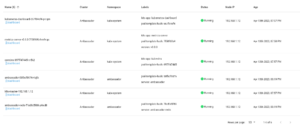How to deploy Ambassador Edge Stack on your Kubernetes Cluster
This tutorial will walk you through the steps to get the Ambassador Edge Stack up and running on a Kubernetes cluster.
Introduction
Ambassador Edge Stack is an open-source tool designed to function as a swiss army knife of sorts for traffic between your Kubernetes clusters and the rest of the world. Ambassador offers Envoy-based ingress control, an API gateway, load-balancing and more through a single tool, allowing teams to reduce the number of individual components they need to install and support, in order to manage application traffic.
Ambassador also offers the advantage of being truly Kubernetes-native: It is configured using Kubernetes annotations and declarative configurations. It supports advanced API-management features like rate-limiting a circuit-breaking, as well.
Prerequisites
- A valid Kubernetes cluster. You can create one quickly for free using Platform9 Managed Kubernetes. Signup for a Free PMK Account Here and create your Kubernetes cluster using PMK. You can also use this guide on any other Kubernetes cluster you may have.
- A Kubectl installation with your Kubernetes cluster from the step above configured as the primary cluster.
- The helm 3 package manager client installed on your local machine. Follow instructions here to install the helm client on your local machine.
Step 1 - Deploy Ambassador
Now, you’re ready to deploy Ambassador to your Platform9 Kubernetes cluster. There are two methods for doing this:
- Using the
edgectlCLI tool, which automates most of the process. - Manually downloading and applying the relevant YAML files.
Whichever method you choose, remember that you’ll need to work within the same terminal where you ran the export kubeconfig command from the previous section (or, you can run the export command again if you open a new terminal). Also remember that the kubeconfig credentials you downloaded from the Platform9 Web console expire after twenty-four hours, so you’ll need to download a new kubeconfig and export it to your environment if you exceed that window.
Install Ambassador with edgectl
Edgectl is a CLI tool that you can download from the website of Datawire, the main developer of Ambassador.
On Linux and macOS, you can download and run the installer with a curl command:
xxxxxxxxxx$ sudo curl -fL https://metriton.datawire.io/downloads/linux/edgectl \ -o /usr/local/bin/edgectl \ && sudo chmod a+x /usr/local/bin/edgectlIf you’re on Windows, download the installer from here.
Once edgectl is downloaded, run the installer with this command:
xxxxxxxxxx$ edgectl installAfter installation completes, you can verify that the Ambassador pods are running under the Pods, Deployments, Services tab in Platform9:

As we can see, Ambassador has been deployed successfully on our Platform9 cluster.
Install Ambassador Manually
Deploying Ambassador manually is only slightly more complicated than using the Edgectl method as described above.
In the terminal where the kubeconfig environment for your Platform9 cluster is active, run this command:
xxxxxxxxxx$ kubectl apply -f https://www.getambassador.io/yaml/aes-crds.yaml$ kubectl wait --for condition=established --timeout=90s crd -lproduct=aes$ kubectl apply -f https://www.getambassador.io/yaml/aes.yaml$ kubectl -n ambassador wait --for condition=available --timeout=90s deploy -lproduct=aesThis will download and apply the YAML files to set up the Ambassador service.
You can then access the Ambassador Web console at your cluster’s IP address. If you don’t know that address, find it with the following command:
xxxxxxxxxx$ kubectl get -n ambassador service ambassador \ -o "go-template={{range .status.loadBalancer.ingress}}{{or .ip .hostname}}{{end}}"Now, there is one more step to perform: To log into the Ambassador Web console, you’ll first need to download and configure edgectl for your Ambassador instance. The Web console will display specific instructions to follow for this purpose. Complete those as directed, and you’ll be up and running.
Step 2 - Create an Ambassador Service
Ambassador uses Kubernetes Custom Resource Definitions to define how requests are mapped to services. The Resource Definitions are YAML files that are applied with kubectl.
Here’s a basic definition for a service that tells Ambassador to map requests for /httpbin/ to the service httpbin.org:
xxxxxxxxxx---apiVersiongetambassador.io/v2kindMappingmetadata namehttpbin-mappingspec prefix/httpbin/ servicehttp//httpbin.orgTo deploy this service, save the definition in a YAML file (we’ll use httpdbin.yaml for this example), then apply it with kubectl:
xxxxxxxxxx$ kubectl apply -f httpdbin.yamlAdditional Resources
For further guidance on how to configure Ambassador Edge Stack, examples of more complex service deployments and tips on best practices to follow, check out the official documentation. Ambassador also has an active Slack channel where you can get support.